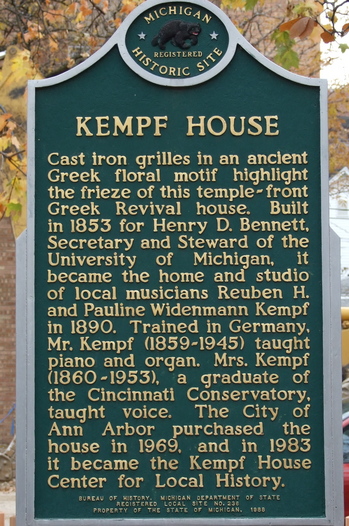Eastern Michigan University grad students help maintain Michigan Historical Marker program
Michigan Executive Order No. 2009-36 spelled the end of the state Department of History, Arts and Libraries. No longer could a state with a budget deficit of $920 million afford such luxuries.
Programs and services provided by the defunct department have been reassigned or eliminated altogether. But thanks to the help of faculty and students at Eastern Michigan University, the Michigan Historical Marker Program will continue.

Due to the help of EMU students, the Michigan Historical Marker Program will continue, despite the state's budget woes.
James Dickson | AnnArbor.com
Once the funding unraveled for the department, and thus the marker program, the State Historic Preservation Office reached out to Ted Ligibel, director of the EMU Historic Preservation program. It's the biggest of its kind in America and the only one in Michigan.
State officials asked if Ligibel's students would lend a hand.
EMU's program in historic preservation regularly enrolls anywhere from 85 to 100 graduate students. Ligibel said the partnership is a no-cost opportunity to provide hands-on experience to graduate students.
Two of Ligibel's students are using their participation in the historical marker program as their final projects. It is likely more students will do the same as the partnership continues.
EMU joins the Michigan Historical Commission and the Michigan History Foundation in the partnership.
The Michigan Historical Commission approves or denies applications for historical markers, while the history foundation administers the marker program. Applications are judged more for truthfulness than for historical value, which is tougher to determine.
More than 1,600 markers have been laid since the first one was placed at Michigan State University on Oct. 22, 1955.
Ed Surovell of Ann Arbor, the president of the historical commission, said the commission reviews and approves applications before handing the information over for EMU students to write the marker texts. A real estate man by trade, Surovell is also a longtime trustee of the Historical Society of Michigan and a major collector of printed materials on Michigan.
Ligibel said two of his graduate students this semester will be using their role in the marker program as their final projects, writing five markers each. Faculty members will give the projects a second look before the texts are returned to the Michigan Historical Commission, which gives final approval.
Prices range from $425 for a wall-mounted marker (only for sites recognized by the state prior to Oct. 1, 1998) to $3,425, depending on the size of the marker and whether text appears on one side or two.
A $250 deposit, refundable if a site's application is denied a marker, is reserved for upkeep.
The process can take up to a year to complete, between reading and vetting the application and writing and approval of the final text. Host communities are responsible for getting the markers in the ground
Sponsors must sign a clause assigning ownership of the markers to the state of Michigan. Once the marker has been planted, it remains until the structure is materially altered.Â
Which is to say: If a barn commemorated with an historical marker is replaced by a home, the marker comes down as well.
James David Dickson can be reached at JamesDickson@AnnArbor.com.

